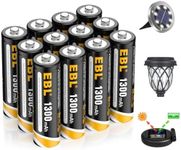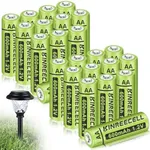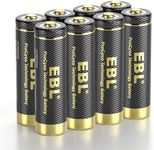Buying Guide for the Best Aa Batteries For Cold Weather
Choosing the right AA batteries for cold weather is crucial to ensure your devices function properly in low temperatures. Cold weather can significantly impact battery performance, so it's important to understand the key specifications that will help you select the best batteries for your needs. Here are the key specs to consider and how to navigate them.Battery ChemistryBattery chemistry refers to the materials and chemical reactions used to generate power. This is important because different chemistries perform differently in cold weather. The main types are alkaline, lithium, and nickel-metal hydride (NiMH). Alkaline batteries are the most common but can struggle in very cold temperatures. Lithium batteries perform well in extreme cold and have a longer shelf life, making them ideal for cold weather. NiMH batteries are rechargeable and perform better than alkaline in the cold, but not as well as lithium. If you need batteries for very cold conditions, lithium is the best choice.
Operating Temperature RangeThe operating temperature range indicates the temperatures at which the battery can function effectively. This is crucial for cold weather use because batteries can lose capacity and efficiency in low temperatures. Look for batteries with a wide operating temperature range, especially those that can handle sub-zero temperatures. For example, lithium batteries often have a range from -40°C to 60°C, making them suitable for extreme cold. Consider the lowest temperature your device will be exposed to and choose batteries that can operate within that range.
Capacity (mAh)Capacity, measured in milliampere-hours (mAh), indicates how much energy a battery can store. This is important because higher capacity means longer runtime for your devices. In cold weather, batteries can lose capacity, so starting with a higher capacity can help ensure your device lasts longer. For instance, lithium AA batteries typically have higher capacities compared to alkaline and NiMH. If you need your device to run for extended periods in the cold, opt for batteries with higher mAh ratings.
Shelf LifeShelf life refers to how long a battery can be stored before it starts to lose its charge. This is important if you plan to store batteries for use in emergencies or infrequent use. Lithium batteries generally have the longest shelf life, often up to 10 years, making them ideal for cold weather storage. Alkaline batteries have a shorter shelf life, around 5-7 years, while NiMH batteries have the shortest, around 3-5 years. If you need batteries that can be stored for long periods and still perform well in the cold, choose those with a longer shelf life.
RechargeabilityRechargeability refers to whether the battery can be recharged after use. This is important for environmental and cost reasons. NiMH batteries are rechargeable and can be a good choice for cold weather if you need to use and recharge batteries frequently. However, they may not perform as well as lithium batteries in extreme cold. Lithium batteries are typically not rechargeable but offer the best performance in cold weather. If you need batteries for regular use and want to recharge them, NiMH is a good option. For the best cold weather performance, non-rechargeable lithium batteries are recommended.




















